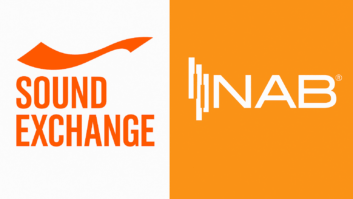Several Reasons Digital Radio Is Attracting Such Attention From the Music Industry
You may be wondering why record labels seem to have recently discovered IBOC technology, and are rallying regulators, legislators and anyone else who will listen to add content protection to music broadcast over HD Radio.
After all, hasn’t radio always broadcast music freely, and hasn’t this seemed to help rather than hinder record sales? OK, IBOC transmission may sound a bit better, but won’t people searching for music still greatly prefer to download songs (legitimately or otherwise) from online sites, or copy them from CDs, rather than record them off-air in real time?
And anyway, isn’t it likely that a song recorded from the radio will have its beginning and/or ending stepped on by DJ banter, commercials or the top/tail of another song (not to mention often being subjected to heavy dynamic-range reduction and other air-chain audio processing)?
Well, the answer to all these questions is very probably yes; but notwithstanding such practical and behavioral constraints, there remain several potentially valid reasons why digital radio broadcasts constitute a new threat to the music industry’s copyrighted material.
These issues have prompted the RIAA to pronounce digital radio as a greater threat to the music industry than (the original) Napster ever was. Of course, the organization said the same thing recently about CD burning, but it may have been correct in that assessment. So what similar dangers do the RIAA and its members now foresee from digital radio?
Aiding the enemy
First, consider that a lot of the “unprotected” music in the file-sharing environment is MP3-encoded at 128 kilobits per second. The HDC codec used by HD Radio (like AAC, WMA and other codecs of its general class) is at least twice as efficient as MP3, meaning that it can produce equivalent or better quality to these files at 64 kbps. This implies that HD Radio music broadcast at the full 96 kbps IBOC-FM payload rate can provide higher audio fidelity than much of the P2P music being shared, and it can even match or exceed the quality of higher-fi 192 kbps MP3 files.
While the newer, “protected” (or “legitimate”) music download services use codecs of roughly equivalent quality to HDC, and at rates of 128 kbps or higher, these services have not yet attracted the bulk of online music users. Despite the strong growth of paid digital music downloading since its inception, the majority of online music activity still takes place in the unprotected MP3 domain.
The RIAA sees unprotected HD Radio as a potentially attractive step forward in quality for the “free” digital music environment.
Musicbots
Another concern of the RIAA regards how future digital radios might actually work, particularly those that could be built as peripheral devices to PCs or other computer-based devices (such as the next generation of powerful, “converged” handheld platforms).
Given the likelihood that most IBOC music broadcasts will include synchronized metadata identifying artists and song titles, the RIAA foresees a simple computer application that could record IBOC broadcasts, store songs as individual audio + metadata files, and then easily build rich libraries of freely obtained music.
Such an application could use the files’ metadata to name, sort and search the files, and “clean” versions could even be stitched together from multiple recordings (thereby eliminating voice-overs and crossfades that may have occurred when the cuts were aired). These relatively high-quality, automatically catalogued files – or entire libraries of them – could then be freely shared online.
It is for this reason that the RIAA is seeking not only a content-protection scheme for digital radio music broadcasts, but also rules that would inhibit a device’s search capabilities after recording. This includes prohibitions similar to those already in effect for Internet radio, such as a limit to the number of consecutive songs that can be played from a single release, and a restriction that recording devices could only record long-form blocks of radio programming (e.g., 30- or 60-minute minimum), which must be retained as single, contiguous files – thereby disallowing subdivision into individual song files.
There has also been discussion of a preference by record companies for the purposeful de-synchronization of metadata from its corresponding audio, to foil the ability of automatic searching of recorded radio broadcasts. For example, this might require broadcasters to withhold transmission of a song’s metadata until a few seconds had passed after the song started playing, and to keep this timing differential variable and randomized.
Cases in point
A final issue deals with some nuances in the digital music world’s ongoing litigation. Several recent court decisions, including one in the U.S. Supreme Court, have bolstered the RIAA’s position that certain music file-sharing practices constitute copyright violations.
In all of these rulings, jurists took great pains to distinguish between the today’s file-sharing practices and the so-called “Betamax” case (Sony v. Universal Studios), which has stood as a guiding precedent in this area of law since its issuance in 1984. A key component of this distinction is that the initial access to music files by accused file-sharers was unauthorized by the copyright holder, and thus the subsequent activity constituted infringement. (It was stipulated that users initially obtained music files from illegal file-sharing services, or they ripped them from CDs that may have been legitimately purchased, but such purchase clearly did not include the right to republish via a file-sharing site.)
This was in stark contrast to the Betamax case, which held that the initial transmission of the content recorded by device-users was via TV broadcasts that were authorized by the copyright holder. Although it could still be argued that widespread redistribution of such content by the Betamax user would also be illegal, the initial capture of the content was legal. Any argument toward limitation of subsequent use of the content is therefore harder to make, especially given that the content was already broadcast in the clear (i.e., without content protection and/or accompanying usage restrictions), and with the copyright holder’s knowledge and permission, so this distribution came with certain known risk of uncontrolled downstream usage. On the other hand, if the content that a user stores on his own equipment is illegally obtained to begin with, any further redistribution of that content would also be illegal, so the argument goes.
Citing this point, record company lawyers see a clear difference between file-sharing that uses content downloaded from P2P sites already declared illegal, or from unauthorized use of a copyrighted disc, versus content that was obtained from authorized and unrestricted broadcasts. They foresee the possibility of not being able to extend the hard-fought recent victories over file-sharers of the past and present to future file-sharers that obtain their music via different (i.e., digital broadcast) means, and thus having to possibly argue such cases anew under different circumstances – and perhaps a higher burden of proof.
For all of these reasons, and possibly more yet to be identified, the subject of content protection on digital radio will remain a high-profile issue on the regulatory, legislative and technical fronts for the foreseeable future. The solution may ultimately rewrite copyright law.







